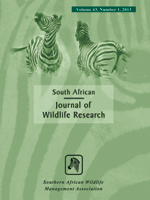We surveyed bats at 30 localities in the Soutpansberg and Blouberg Mountains within the newly proclaimed Vhembe Biosphere Reserve (VBR) of northern South Africa, based on ANABAT acoustic recordings (63 nights) conducted in parallel with captures of 260 individuals from harp traps (29 trap-nights) and mist nets (54 trap-nights), and searches of ten day-roosts and two night-roosts. Twenty-four species of bats were captured, or positively identified from roosts, out of 44 species previously recorded for the VBR. For those species captured during the study and one additional commonly recorded species, Chaerephon ansorgei, which was not captured, we compiled a library of ANABAT call parameters for reference calls, based on released bats or bats emerging from known-species roosts. Reference calls were obtained from the study area where possible, or from the closest possible site in the savanna region of southeastern Africa. Using principal component analysis and plots of frequency histograms of selected parameters, we investigated the extent to which reference calls of different species could be distinguished on call parameters. Complete separation was obtained for most species but certain species-pairs or trios showed overlap, particularly amongst molossid bats. Accurate identification of unknown calls was complicated by natural intraspecific variation in echolocation call structure due to habitat and behaviour in our species-rich study area. We advocate a conservative approach whereby species-pairs or groups with overlapping calls are treated as single ‘species’. Such underestimation can be partly corrected using rarefaction approaches, as illustrated by data collected from Blouberg Nature Reserve. Particularly when surveying bats in species-rich areas such as the eastern savannas of southern Africa, both acoustic and capture-based surveys are necessary to accurately estimate true species richness. From our capture data and roost searches, we recorded nine to 14 species at four west—east, grouped localities defined by this study. Adding acoustic data using a conservative approach to classify overlapping species-pairs or trios, we obtained minimum richness estimates of 15 to 21 species, values which were close to those predicted by a recent macro-ecological model. We found no evidence for a west—east increase in richness with increasing precipitation as predicted by coarse-scale macroecological predictions.
How to translate text using browser tools
1 April 2013
Diversity of Bats in the Soutpansberg and Blouberg Mountains of Northern South Africa: Complementarity of Acoustic and Non-Acoustic Survey Methods
Peter John Taylor,
Sandie Sowler,
M. Corrie Schoeman,
Ara Monadjem
ACCESS THE FULL ARTICLE
Anabat
bat species richness
Chiroptera
Limpopo Province
South Africa
species diversity





